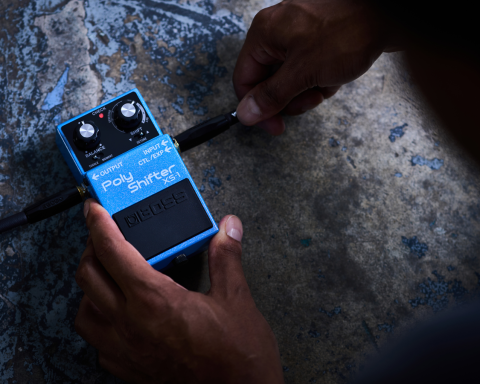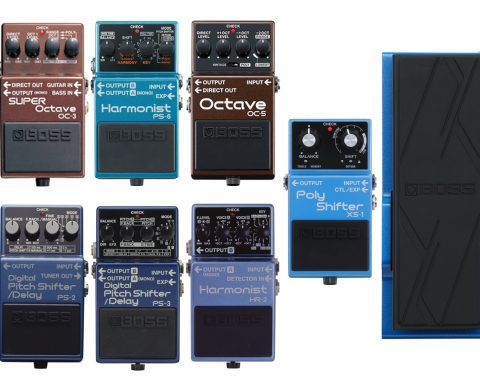The EQ pedal is an essential tool for guitarists. It is incredibly versatile and works in many different ways for different applications in a guitar setup. EQ can be an effect in its own right, a preamp, or a precision tool for crafting and defining guitar tone. Still, despite its resume, EQ is often overlooked as less glamorous than other effects. The ability to boost or cut the volume of particular frequencies is a doorway to a refined tone. When used creatively, the humble EQ pedal can be a game-changer for a setup. Learn how EQ can fine-tune a guitar sound.
What is EQ?
The term EQ stands for equalizer or equalization and refers to the frequencies in the sonic spectrum. In simple terms, and for application to guitar tone, this refers to the bass, middle, and treble frequencies. Different amplifiers and pedals split these frequencies into bands, offering control over specific ranges.
An amplifier, for example, might break these up into three separate controls: bass, middle, and treble. In this instance, each control handles an extensive range of frequencies, limiting the precision with which we can shape the tone. By contrast, a graphic EQ pedal can divide the frequency spectrum across more controls. This allows for precision boosting and cutting specific frequencies, making it ideal in many situations.
Setup Considerations
As the EQ pedal is such a versatile tool, it also works in several different positions in an effects chain. We can place it at the start of an effects chain, exciting the preamp of an amplifier and adding extra gain when used to boost frequencies. In this position, EQ can add additional gain to overdrive or distortion pedals, acting as a second drive option.
An EQ pedal also works well positioned after drive effects to shape the specific frequency response of an overdrive. It can perform a similar role when in an amplifier’s effects loop. Adding an EQ pedal to the effects loop will allow guitarists to tailor their tone without adding gain.
Five EQ Pedal Uses
Preamp
An EQ pedal can be a great way to make the most of an amplifier. Set up correctly and used as an always-on preamp, an EQ pedal can help to enhance an amplifier’s desirable characteristics. One example is boosting upper mids to help rhythm work cut through the mix and single out, reduce, or remove unwanted frequencies. This feature is handy for tightening up the low end.
High-gain amps are often an excellent pairing for an EQ pedal to help shape and tailor the amp’s sound. Driving the preamp of a high-gain amplifier creates a thick, full-bodied overdrive, which is tough to replicate with pedals. But creating this much gain is like letting a wild beast off the leash. Running an EQ pedal into the front of the amplifier helps rein in the beast and direct its aggression toward the frequencies that sound best.
In this case, try boosting a relatively broad range of the upper mid frequencies (roughly the 400 Hz-1.6 kHz sliders on a BOSS GE-7). This will give a desirable midrange bump to the tone, perfect for a tight, crisp, and articulate drive tone. Next, decrease the bass frequencies slightly to add clarity and precision to the tone. On a BOSS GE-7, reduce the 100 Hz slider slightly. If this setting isn’t enough, bring down the 200 Hz slider a bit.
"Set up correctly and used as an always-on preamp, an EQ pedal can help to enhance an amplifier’s desirable characteristics."
Solo Boost
Solo Boost
Players often use EQ as a boost to enhance guitar solos. A guitar solo’s role is like a vocal melody, unlike rhythm work that needs to sit alongside the other instruments. Solos need to soar above the rest of the band and sit front and center in the mix. Boost pedals do this by increasing the guitar’s volume, but an EQ pedal can achieve a similar result with much more precision.
Most EQ pedals include a master control boosting up to around 15 dB. We can achieve this by leaving the EQ settings flat and increasing the level control. Still, a guitar solo often doesn’t need a boost to the whole frequency range to sound good. A simple kick to the upper mids and treble frequencies is sufficient and will sound more cohesive with the rest of the mix than a blanket volume boost.
Instead of a Second Amp Channel
An EQ pedal can be convenient for transforming single-channel tube amps into versatile tone boxes. Frequently, a single-channel tube amp is a perfect tool for creating creamy, organic overdrive tones. But what about when a clean tone is necessary?
With the EQ pedal running into the front of the amplifier, reduce the master level control of the pedal. This will decrease how hard we hit the preamp, lessening that classic tube breakup. However, this might also leave us with a relatively muted, unexciting tone. Next, experiment with boosting and cutting the mid frequencies. Cutting mid frequencies will often expose and add a little sparkle to the high frequencies. This creates that clean, scooped guitar tone we all want.
"Cutting mid frequencies will expose and add a little sparkle to the high frequencies. This creates that clean, scooped guitar tone we all want."
Overdrive
Using an EQ in the opposite manner described above is an excellent alternative to an overdrive. With a tube amplifier set to the edge of breakup, adding an overdrive pedal can often be too much. It’s challenging to find a drive pedal that accentuates the correct frequencies of a lightly driven amp. Adding an EQ to the front of an amp, boosting the level to excite the preamp, and adding a mid bump to create a foot-switchable overdrive tone. Plus, it maintains the amplifier’s clarity and punch. It’s the perfect solution for guitarists who love their amp tone but want even more of it.
Cocked Wah
Cocked wah is the effect of engaging a wah pedal, but instead of using it rhythmically to accentuate a guitar part, leaving it in a fixed position. This setting creates a jarring, piercing tone, perfect for giving an intro some flavor or making a lead line leap out of the mix. This sort of effect was famously used by Mark Knopfler on Dire Straits’ “Money for Nothing.” It has also become the backbone of the unique guitar tone of Omar Rodriguez Lopez.
This sort of effect requires using the control bands of an EQ pedal to their extreme. Try boosting all frequencies from 400 Hz-1.6 kHz and cut everything else to create this tone. It’s worth noting that increasing the volume of particular frequencies also raises the noise floor and can create some amp hiss. For an open wah effect, subtracting the unwanted frequencies is as essential as boosting the desired ones. Try dropping all the other frequency bands to their minimum first, then increase the mid frequencies.
"For an open wah EQ effect, subtracting the unwanted frequencies is as essential as boosting the desired ones."
Tailoring Tone
The EQ pedal is a versatile and creative tool that can help guitarists specifically tailor their tone without compromise. Whether fashioning a second amp channel, creating a lo-fi radio speaker sound, or replacing an overdrive, EQ has a place on every player’s board. This pedal’s broad range of applications extends to the pedals we paired it with to create bold new tones.







